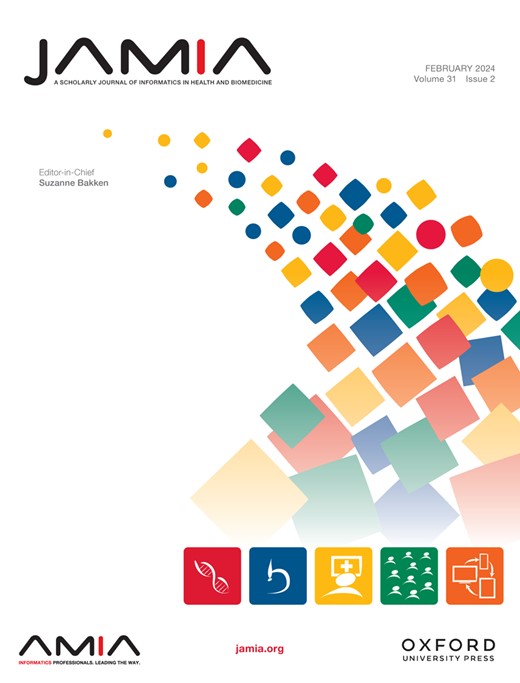通过检查性别不一致的情况来确定电子健康记录的准确性。
IF 4.7
2区 医学
Q1 COMPUTER SCIENCE, INFORMATION SYSTEMS
Journal of the American Medical Informatics Association
Pub Date : 2024-09-10
DOI:10.1093/jamia/ocae236
引用次数: 0
摘要
目的:由于研究和临床护理对电子健康记录(EHR)的依赖性越来越强,因此有必要采用可靠的方法来评估数据质量和识别不一致性。为了满足这一需求,我们利用特定性别的医疗条件开发并应用了不一致率(IR)。在这项横断面研究中,我们使用了 All of Us 研究计划最新的第 7 版(v7)电子病历数据来识别普遍存在的性别特异性病症,并评估了不一致病例的发生率,量化为 IR。结果在 92 597 名男性和 152 551 名女性中,我们识别出 167 种普遍存在的性别特异性病症。在患有这些性别特异性疾病的 37 537 名生理男性和 95 499 名生理女性中,我们发现 IR 的总体比例为 0.86%。如果试图将非两性参与者包括在内,则会导致总体 IR 值升高。此外,相当一部分条件不一致的参与者也出现了与其生理性别一致的条件,这表明准确记录和错误记录并存。这些不一致的情况在地理上或时间上都不是孤立的,这表明电子病历数据的完整性存在系统性问题。将IR评估扩展到非两性参与者或非基于性别的病症仍然是一个挑战。结论:当性别病症特异性IR应用于成人群体时,它为电子病历的数据质量评估提供了一个有价值的指标。本文章由计算机程序翻译,如有差异,请以英文原文为准。
Navigating electronic health record accuracy by examination of sex incongruent conditions.
OBJECTIVE
The increasing reliance on electronic health records (EHRs) for research and clinical care necessitates robust methods for assessing data quality and identifying inconsistencies. To address this need, we develop and apply the incongruence rate (IR) using sex-specific medical conditions. We also characterized participants with incongruent records to better understand the scope and nature of data discrepancies.
MATERIALS AND METHODS
In this cross-sectional study, we used the All of Us Research Program's latest version 7 (v7) EHR data to identify prevalent sex-specific conditions and evaluated the occurrence of incongruent cases, quantified as IR.
RESULTS
Among the 92 597 males and 152 551 females with condition occurrence data available from All of Us and sex-conformed gender, we identified 167 prevalent sex-specific conditions. Among the 37 537 biological males and 95 499 biological females with these sex-specific conditions, we detected an overall IR of 0.86%. Attempt to include non-cisgender participants result in inflated overall IR. Additionally, a significant proportion of participants with incongruent conditions also presented with conditions congruent to their biological sex, indicating a mix of accurate and erroneous records. These incongruences were not geographically or temporally isolated, suggesting systematic issues in EHR data integrity.
DISCUSSION
Our findings call attention to the existence of systemic data incongruences in sex-specific conditions and the need for robust validation checks. Extending IR evaluation to non-cisgender participants or non-sex-based conditions remain a challenge.
CONCLUSION
The sex condition-specific IR, when applied to adult populations, provides a valuable metric for data quality assessment in EHRs.
求助全文
通过发布文献求助,成功后即可免费获取论文全文。
去求助
来源期刊
CiteScore
14.50
自引率
7.80%
发文量
230
审稿时长
3-8 weeks
期刊介绍:
JAMIA is AMIA''s premier peer-reviewed journal for biomedical and health informatics. Covering the full spectrum of activities in the field, JAMIA includes informatics articles in the areas of clinical care, clinical research, translational science, implementation science, imaging, education, consumer health, public health, and policy. JAMIA''s articles describe innovative informatics research and systems that help to advance biomedical science and to promote health. Case reports, perspectives and reviews also help readers stay connected with the most important informatics developments in implementation, policy and education.

 求助内容:
求助内容: 应助结果提醒方式:
应助结果提醒方式:


